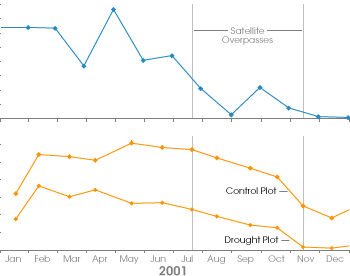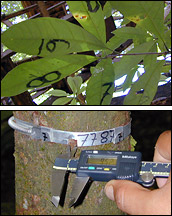

Artificial El Niño Gets Underway |
|||||||||||||||||||||||||||
By January 2001, the experiment was officially underway. Between January 7 and May 31 about 1,368 millimeters of rain fell over the two sites. Over the course of the wet season, rainfall averaged 9.5 millimeters per day, and the structure Nepstad and his crew had constructed diverted about 50 percent of that from the site, bringing the average down to 4.7 millimeters of rain a day, simulating El Niño drought conditions. After the wet season ended, the panels were removed. As the dry season progressed, the effects of the rainfall diversion became obvious. By the end of the dry season in November 2001, the amount of soil water available to plants at depths between 0 and 11 meters in the “drought” plot was several hundred millimeters less than the control site, where Nepstad didn’t interfere with the normal rainfall. Leaf area was 17 percent lower than it was at the control site, and mid-day leaf water potential was 30 percent lower. |
|||||||||||||||||||||||||||
 |

Not surprisingly, all this stress affected tree growth. Net primary production (the total amount of carbon that winds up in trees as a result of what they take in during photosynthesis minus what they give off during respiration) was almost thirty percent less in the drought plot than in the normal plot; the mass of carbon in the control plot increased by 2.6 megagrams, while in the drought plot, it increased by only 1.9 megagrams. |
At the field experiment site, rainfall (top graph) began in January, peaked in May, and dropped off dramatically in July. Plant available water (bottom graph) increased and remained high at the control site (top line) throughout the rainy season, while at the drought site (bottom line), available water was already declining by mid-February, bottoming out at 400 millimeters by the end of the dry season in December. Hyperion collected data over the plots in July and November (grey lines). (Graph courtesy Asner et. al.) | |||||||||||||||||||||||||
The fact that drought interfered with the tree growth isn’t surprising. What is surprising, says Nepstad, is where in the tree this slow-down occurs. “We thought that early drought stress would show up first in leaves—that leaf area would decrease significantly and that litterfall would increase as leaves died and dropped off the trees,” said Nepstad. “Instead, we found only small decreases in leaf area, and litterfall actually decreased. It turns out that wood production is the most sensitive to drought stress. Trees just stop growing in diameter, which has important consequences for timber production.” The second of Nepstad’s two big surprises was which trees were most likely to die as a result of the drought stress. It seemed logical that a smaller tree would have a harder time in a drought than a large tree, since the smaller tree’s root system couldn’t reach as deeply into the soil for water as a larger tree’s could. Instead, says Nepstad, “the first trees to die are the big ones, probably because they are in the sun high in the canopy.” |
 Scientists were surprised to discover that their simulated drought decreased wood production more than it did leaf area. Scientists numbered some individual leaves (top image) to monitor leaf area and mortality. Scientists also measured the girth of tree trunks (bottom image) over the course of the experiment. (Photographs courtesy Paulo Brando) | ||||||||||||||||||||||||||

Asner’s analysis of the Hyperion data confirmed that the commonly used indicators of vegetation greenness and leaf area just weren’t sensitive enough to detect the small differences against a background of such lush vegetation. When he calculated net primary production (net carbon intake) based on the traditional greenness observations collected by Hyperion, the results suggested that the carbon content in the drought plot and the control plot were the same. |
Before the experiment, the scientists thought that bigger trees, with their larger root systems, would survive the drought better than smaller trees. Instead, they discovered that the big trees that extend above the forest canopy (pictured at left) were the first to die. (Photograph courtesy 3rd LBA Scientific Conference) | ||||||||||||||||||||||||||
The indicators that made use of the new hyperspectral information from Hyperion were much more successful at detecting the changes in carbon content brought about by drought stress. When Asner factored in observations of xanthophyll pigment activity (increased xanthophyll activity is a sign that a tree is using light efficiently), anthocyanin pigment activity (reddish anthocyanin pigments are most visible in newly formed leaves and buds), and canopy water content, the satellite-based calculations of net carbon intake came very close to matching the growth that had been measured on the ground. |
Based on field measurements, net primary production (NPP) at the drought site was 73 percent less than the control site in 2001 (bottom row of table). Rows 2-4 show the ratio of NPP at the two sites estimated from different types of satellite observations in July, November, and for the entire year. Estimates based on hyperspectral observations of chlorophyll-helper pigments and canopy water content matched the ground-based measurements more closely than did the estimate based on greenness alone. (Table courtesy Asner et al.) |